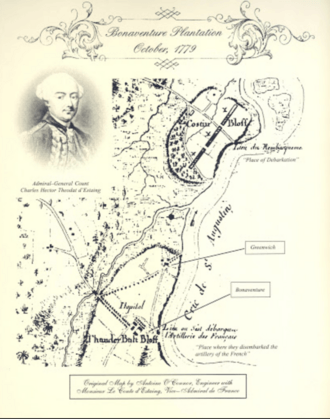Bonaventure Plantation facts for kids
Quick facts for kids Bonaventure Plantation |
|
|---|---|

An October 1779 map by Antoine O'Connor, chief engineer of French Admiral-General Charles Henri Hector d'Estaing, showing the location of Bonaventure
|
|
| General information | |
| Location | Colonial Savannah, Province of Georgia |
| Coordinates | 32°02′37″N 81°02′42″W / 32.0435°N 81.0451°W |
| Completed | 1762; rebuilt after 1771 |
| Destroyed | 1771 (fire); 1804 (fire) |
| Owner |
|
Bonaventure Plantation was a large estate in colonial Savannah. It was like a big farm with a main house. Today, the land is part of the Greenwich and Bonaventure cemeteries.
The plantation covered about 600 acres (2.4 km²). It had a main house and a private cemetery. It was located on the Wilmington River. This was about 3.5 miles (5.6 km) east of the original Savannah settlement.
Contents
Founding the Plantation
The plantation was started in 1762 by Colonel John Mullryne. He was an officer in the British Army. Mullryne moved from England to Charleston, South Carolina, and then to Savannah.
A writer named Charles Colcock Jones Jr. described the area in 1890. He said the high ground and river views made it a top spot near Savannah. The first house was built facing a beautiful garden. This garden had terraces that went down to the river.
The Tattnall Family Takes Over
The Tattnall family later owned Bonaventure. This happened after Josiah Tattnall Sr. married Mary Mullryne. Mary was the youngest daughter of John Mullryne. Their son, Josiah Tattnall Jr., was born at the plantation in 1764.
When Claudia Mullryne, John's wife, made her will in 1781, she left the main house to her daughter, Catharine Moore. After Catharine's death, Josiah Tattnall Jr. would inherit the house. He would also get 600 acres of land next to his father's property.
Fires and Rebuilding
The first house at Bonaventure was made of English brick. It was destroyed by a fire on January 7, 1771. A story says that a dinner party was happening when the fire started. The host calmly told guests to take their plates and finish dinner in the garden. They watched the house burn down. A new brick mansion was built to replace it.
Another fire destroyed the mansion in 1804.
The Revolutionary War and Ownership Changes
During the American Revolutionary War, things changed. In 1776, the people of Savannah arrested the royal Governor, James Wright. John Mullryne and Josiah Tattnall Sr. helped the Governor escape. They took him through Bonaventure to a British ship nearby.
Because they supported the British, the American government took the Bonaventure estate in 1782. It was sold at a public auction. John Habersham, a friend of the Tattnall family, bought it. He then sold it back to Josiah Tattnall Jr. in 1788. Josiah Jr. had married Harriet Fenwick two years earlier. They had three children who grew up: Edward, Harriet, and Josiah III.
John Mullryne and Josiah Tattnall Sr. had left the colonies during the war. John Mullryne died in the Bahamas in 1786. Josiah Tattnall Jr. returned to Savannah around 1785.
Later Tattnall Generations
Josiah Tattnall Jr.'s wife, Harriet, died in 1802. She was buried at the plantation with five of their children who died young. Josiah Jr. died in 1803 in the Bahamas. Their children, now orphans, were raised in London, England.
In 1817, Josiah Tattnall Jr.'s children got their family lands back. After his sister and brother died, Bonaventure went to Josiah III. He joined the United States Navy in 1812. He also fought in the Mexican–American War.
Becoming a Cemetery
The Tattnall family owned Bonaventure until 1846. Then, Captain Peter Wiltberger bought the property. The sale did not include the Tattnall family cemetery. However, Wiltberger agreed to take care of it.
Captain Wiltberger died in 1853. He was buried at the estate with his wife and son. His other son, Major William Henry Wiltberger, inherited Bonaventure. After fighting in the American Civil War, he decided to turn part of Bonaventure into a public cemetery. He started the Evergreen Cemetery Company in 1868.
Major Wiltberger died in 1872 and was buried in the cemetery he helped create. After his death, the Evergreen Cemetery Company took full control of Bonaventure. The city of Savannah bought the Evergreen Cemetery of Bonaventure in 1907. Greenwich Cemetery became part of Bonaventure in 1933.
Today, Bonaventure Cemetery is a famous place. Several important members of the Tattnall family are buried there. You can find their graves in section E, lot 1, on Mullryne Way. Next to it is section F, called Plantation Square. This is likely where the old mansion once stood.
Here are some Tattnall family members buried in Bonaventure Cemetery:
- Harriet Tattnall (1769–1802), plot 11
- Josiah Tattnall Jr. (1764–1803), plot 14
- Edward Tattnall (1788–1832), plot 10
- Josiah Tattnall III (1795–1871), plot 1
No members of the Mullryne family are known to be buried at Bonaventure or Greenwich cemeteries.

